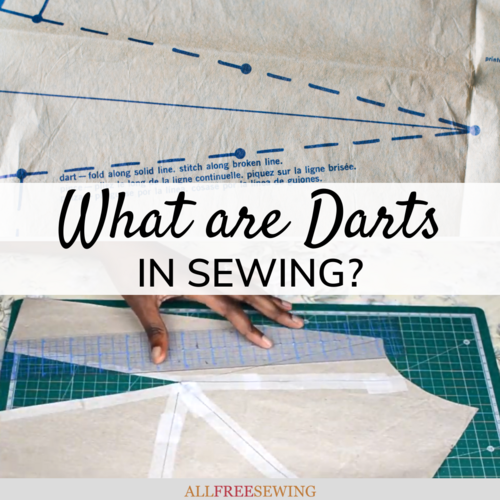Solved: What are Darts in Sewing?
Never wonder again how darts are used in sewing patterns, what types of sewing darts there are, or how to sew darts after reading this simple sewing guide!
If you sew or have used a pattern recently, you may have the question: what are darts in sewing? A dart is a folded wedge of fabric, similar to a triangle, that is sewn in order to give a garment a 3-dimensional contour.
Oftentimes this is to allow space for, accentuate, or flatter a female figure’s natural curve.
Darts manipulate fabric by folding it and sewing it to a point, known as the apex. The two sides of a dart, which run from the widest part of the dart to the apex, are referred to as its legs.
Though darts all have this basic composition, there are several types of sewing darts. Each type is specialized for a certain area of the garment, like the bust, waistline, and shoulder.
Below, you'll learn about the different types of darts (there are more than you might think!), along with how to sew darts.
We are also including a few guides and projects along the way to help you grow in your skills.
Sign Up For More Free Patterns >>>
Table of Contents
Types of Sewing Darts
Because different elements of the figure require a different fit, the type of dart used for each element changes.
Darts often vary in placement, angle, and length. There are many variations of darts, but there are a few standard types that every sewist should be familiar with.
Though the following list does not include every type of dart in existence, those listed are among the most frequently used in sewing projects.
Most of the following types of darts are identified in Rochelle New’s Craftsy article, 7 Types of Darts You Need to Know.
- Plain or Standard Dart: the most common type of dart, the plain dart is often found around the bust, waist, and hips of a garment.
- Bust Dart: as the name implies, the bust dart is often placed at the side of the garment with the apex ending near the bust.
- Curved Dart: when there isn't a straight line, that's when you'll see curved darts. These are most commonly found on pants or skirts.
- French Dart: an elongated bust dart that begins on the side seam near the waist and has an apex that points upwards towards the bust.
- Shoulder Dart: a dart that is placed on the shoulder of a garment. The apex is placed either at the shoulder with the legs pointing towards the arm, or at the bust with the legs pointing towards the shoulder.
Image below: Dart Manipulation Guide
- Neck Dart: this dart is positioned with its apex pointing downwards and away from the neck of a garment.
- Serged Dart: using a serger/overlocker, these darts are used most commonly with knits and help speed up sewing.
- Waist Dart: a dart with its apex at the waist. The legs of the dart can extend either upwards towards the bust or downwards towards the waist.
- Dart Tuck: a dart variation in which the apex is left open. This dart looks similar to a pleat.
- Elbow Dart: a dart that has an apex just below the elbow and the legs extending upwards towards the shoulder. This dart is meant to accommodate the natural bend of the elbow.
- Double Pointed/Ended Dart: also referred to as fish-eyed or closed. These are two darts that are joined together at the widest end. This dart is often placed on the bodice of a garment with one apex pointing towards the bust and one apex pointing towards the waist.
Image below: Dart Manipulation – Multiple Darts
How to Sew Darts
Though it may seem daunting to sew darts into garments, it’s actually a simple process. With a few helpful tips and a step-by-step tutorial, you’ll be sewing form-fitting garments in no time! These steps are outlined in the Seamwork article, Tutorial: How to sew darts.
Positioning the Darts:
- To position a dart, make sure the apex is positioned near the high point of a curve, but not directly on it.
- The wider the dart, the higher the point of the curve.
Instructions for Sewing Darts:
- Mark on your fabric with tailor’s chalk where you would like the legs and apex of the dart to be.
- Fold the fabric so that the legs match up, and pin them together. One leg of the dart should lay on top of the other.
- Begin at the widest part of the dart. This will ensure that the dart lies flat. Sew towards the apex of the dart and 4-5 stitches past the tip.
- Don’t backstitch at the narrow end of the dart because this will distort the point of the dart. Instead, tie the tails of thread in a knot, being careful not to pull so tightly that the fabric puckers.
Image below: How to Sew a Dart
Want More?
Ultimate FAQs Guide >>
Do you sew your own clothing?
Let us know in the comments!

